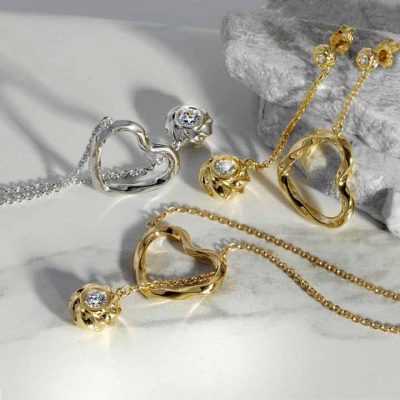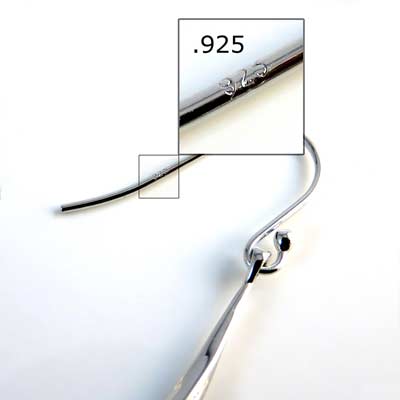Fun Reading, Tips & Recommendations
A Guide To Buying Hypoallergenic Jewelry
When buying jewelry, you might have come across sellers using the term “hypoallergenic” as a selling point. Many people have allergies to common metals, and this is often triggered by the jewelry they wear. Buying hypoallergenic jewelry is the easiest way to counteract these problems.
However, when a piece of jewelry is labeled as hypoallergenic, this simply means that it is less likely to cause allergies than other pieces. It is not a scientific or medical term. Hypoallergenic often means nickel-free but this is not always the case. Therefore, it is important to make sure that you know what metals to look for and which to avoid.
It’s important to know which metals you’re sensitive to, and which are safe. This way, you’ll be able to make an informed decision when buying hypoallergenic jewelry.
What Does An Allergic Reaction To Metal Look Like?
Many people, around 15% of the population, are allergic to various metals. This is because of immune system conditions that cause a person’s body to mistake certain types of metals as toxins. To warn the wearer, the body triggers a painful reaction.
If you have a metal allergy, you will get uncomfortable symptoms around the piece. These may include redness, rash, itchiness and blistering. If you have a hypersensitivity to metal, you may have a very negative reaction. These could include symptoms such as depression, fatigue, and arthritis. If you have any of these symptoms, you should be buying hypoallergenic jewelry.
The most common metal allergy is to nickel. This is a natural white metal which is often mixed with other metals to create an alloy. Other metal allergies include copper or brass.
It’s a common misconception that staining of the skin is a sign of metal allergies. However, this is just a reaction to perspiration. Certain cheap metals oxidize against the skin, causing those green or blue stains.
If you suspect you have a metal allergy but you aren’t sure, your doctor or dermatologist will be able to confirm this for you. It’s important to make sure you know what you’re allergic to. Your health is at stake and allergic reactions can have serious outcomes. You also don’t want to spend a lot of money on a piece of jewelry you won’t be able to wear!
Types Of Metals To Look For
Depending on your skin sensitivity, you may need to avoid nickel, copper, brass, or all of these. What metals are safe?
Gold
Gold on its own is a fantastic hypoallergenic option. However pure gold, also known as 24 karat gold, is very soft. It is actually too soft to make into jewelry that will hold its shape. This is why most gold jewelry is around 14 karat. This means that the other 10 karats are made of other stronger metals.
When buying gold jewelry, make sure to find out what the other metals in the alloy are. If you have an allergy to nickel, you should make sure that the piece is nickel-free. Instead, go for an alloy with different components. Plated jewelry is also a good alternative.
Silver
Just like gold, pure silver is too soft to make jewelry with. Therefore, it is usually strengthened with other metals and sold as an alloy. This is called sterling silver.
.925 sterling silver is 92.5% pure silver and 7.5% other metals. These are usually nickel, copper or zinc. Depending on what type of metal is used and how your body reacts to it, this can cause skin irritation.
However, if you aren’t sensitive to the metals in the alloy, .925 sterling silver is an affordable and versatile hypoallergenic choice.
Titanium or niobium
Consider niobium or titanium when buying hypoallergenic jewelry. These metals are often used for creating medical implants and tools. This is because they are strong, lightweight and resistant to corrosion.
These metals are never plated or painted, but instead cured in an electric bath. This means that the color will never wear down and they barely tarnish. You can find titanium and niobium in a wide range of colors.
While very similar, the main difference between the two is that niobium has a smoother surface finish. While other types of metals used for earring posts may slightly irritate the earlobes, niobium is extremely gentle. It is also a little rarer, and sometimes more expensive than titanium.
Rhodium or platinum
These precious types of metal are from the same family, and are some of the most valuable in the world. Their value comes from how durable and strong they are. These metals hardly tarnish, so are often used as plating over cheaper metals.
When you buy platinum or rhodium, you can be sure you’re investing in great quality pieces.
What To Think About When Buying Hypoallergenic Jewelry
When shopping for hypoallergenic jewelry, remember that quality often comes with a price tag. However, you should view your jewelry purchases as an investment. You may be shocked at the price jump when you begin buying hypoallergenic jewelry. For instance, a rhodium plated bracelet will be more expensive than a cheap nickel alloy.
But remember: your hypoallergenic jewelry will not tarnish like your cheaper pieces will. It will be less prone to breaking or getting damaged. The piece won’t stain your skin blue – which no one wants! When you think about all the benefits, I’m sure you’ll agree that the higher price tag is well worth it.
If you know that you’re sensitive to metals, be careful when you see plated jewelry. Silver, gold or rhodium plated jewelry is often an affordable and elegant option. However, if you’re sensitive to the metal underneath, this may cause a nasty allergic reaction if the plating wears down. Make sure the jewelry you buy has a neutral metal under the plating.
If you want to be extra careful when buying hypoallergenic jewelry, you could consider trying non-metal pieces. When it comes to jewelry materials, plastic, glass and wood are all unique options. They often look a little more casual than metals, and can be a fresh addition to your look.
No matter what metal you choose, make sure to ask about the makeup of the piece you’re buying. It would be awful to spend money on a piece of jewelry only to later find it irritates your skin. Any good jewelry seller will be able to tell you about each metal that the piece is made from.
Buying Hypoallergenic Jewelry From ARY D’PO
All ARY D’PO earrings have solid sterling silver hooks and wires plated with gold, rhodium or platinum. .925 sterling silver, the most common variety, consists of 92.5% of pure silver and 7.5% other metals. If nickel is used among those 7.5% of metals, this may cause an allergic reaction.
For this reason, at ARY D’PO we keep our jewelry nickel-free. Instead of nickel, we use metals such as brass as far less people are sensitive to it. We always take steps to ensure a comfortable and safe experience for our customers. We are clear about which materials we use, and you can find this information in any of our product descriptions.



